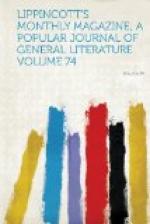ILLUSTRATIONS
Facade of the Spanish
division, main building.
Facade of the Egyptian division, main
building.
Facade of the Swedish division, main building.
Facade of the Brazilian division, main
building.
Dom Pedro, emperor of Brazil.
Japanese carpenters.
Facade of the division of the Netherlands,
main building.
The Corliss engine, furnishing motive-power
for machinery hall.
Interior of cook’s world’s
ticket-office.
French restaurant la Fayette.
The Mammoth Rodman gun.
Scene at one of the entrances to the grounds—the
turnstile.
Scene in A burial-ground.
The sultan Abdul-Assiz.
Turkish cow-carriage.
Entering A mosque.
Castle of Europe, on the bosphorus.
Fortress of Riva, and the black sea.
Turkish quarter—Stamboul.
Obelisk of Theodosius.
Shepherds.
LIPPINCOTT’S MAGAZINE
OF
POPULAR LITERATURE AND SCIENCE.
June, 1876.
THE CENTURY—ITS FRUITS AND ITS FESTIVAL.
VI. The display—introductory.
[Illustration: Facade of the Spanish division, main building.]
All things being ready for their reception, how were exhibits, exhibitors and visitors to be brought to the grounds? To do this with the extreme of rapidity and cheapness was essential to a full and satisfactory attendance of both objects and persons. In a large majority of cases the first consideration with the possessor of any article deemed worthy of submission to the public eye was the cost and security of transportation. Objects of art, the most valuable and the most attractive portion of the display, are not usually very well adapted to carriage over great distances with frequent transshipments. Porcelain, glass and statuary are fragile, and paintings liable to injury from dampness and rough handling; while an antique mosaic, like the “Carthaginian Lion,” a hundred square feet in superficies, might, after resuscitation from its subterranean sleep of twenty centuries with its minutest tessera intact and every tint as fresh as the Phoenician artist left it, suffer irreparable damage from a moment’s carelessness on the voyage to its temporary home in the New World. More solid things of a very different character, and far less valuable pecuniarily, though it may be quite as interesting to the promoter of human progress, exact more or less time and attention to collect and prepare, and that will not be bestowed upon them without some guarantee of their being safely and inexpensively transmitted. So to simplify transportation as practically to place the exposition buildings as nearly as possible at the door of each exhibitor, student and sight-seer became, therefore, a controlling problem.




